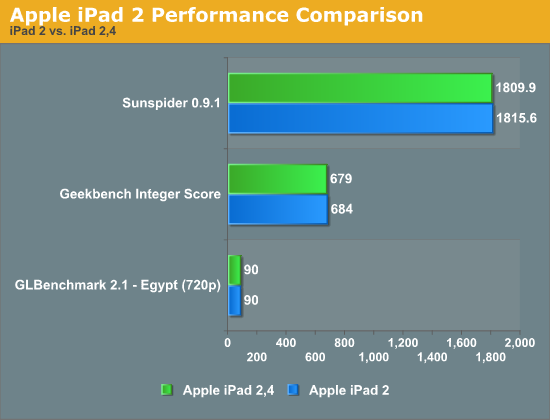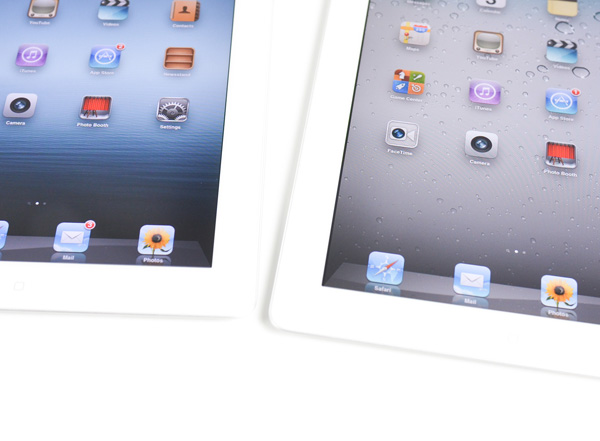The iPad 2,4 Review: 32nm Brings Better Battery Life
by Anand Lal Shimpi on May 4, 2012 12:50 AM ESTDecreased Power Consumption
We obviously know the impact of the new SoC on battery life but here's a look at just how much less power the new platform draws in various conditions. Note that for whatever reason the iPad's power consumption when sitting at the home screen is actually higher than when running our 720p High Profile video playback test. The results were consistent as I tested multiple times across multiple iPads. I have a few thoughts as to what could be happening here:
| Tablet Power Consumption (including Display) | ||||||
| iPad 2,4 | iPad 2 | iPad (3rd generation) | ||||
| Homescreen | 2.7 W | 2.9 W | 6.1 W | |||
| Sunspider | 3.4 W | 4.3 W | 7.6 W | |||
| Moonbat (20 x 4) | 3.9 W | 5.0 W | 8.3 W | |||
| GLBench Egypt (native res) | 3.8 W | 4.5 W | 9.6 W | |||
| GLBench Egypt (offscreen 720p) | 4.1 W | 4.8 W | 10.0 W | |||
| Infinity Blade 2 | 4.3 W | 5.1 W | 10.3 W | |||
| Riptide GP | 3.9 W | 4.7 W | 10.2 W | |||
| Video Playback (720p HP) | 2.2 W | 2.4 W | 4.9 W | |||
Under heavy CPU load (multithreaded Sunspider) we see a 28% increase in power consumption from the 45nm iPad 2,1 compared to the newer 2,4. Keep in mind that we're looking at peak power consumption here, which helps explain the smaller gap on the GPU side than what we saw in our battery life tests. What this data does show however is that the power efficiency improvements can be just as significant for CPU bound workloads, it's simply harder to find workloads that are CPU bound for long periods of time.
Looking at the 3rd generation iPad data reminds us of just how power hungry that platform is. It truly is Apple's performance halo, and it's the perfect target for a 32nm SoC in the future.
The iPad 2 battery life comparison numbers were generated on a lightly used iPad 2 with fewer than 20 charge cycles. While it's possible that some of the differences highlighted on the previous page are due to differences in the batteries between these two devices, it's likely that the variance is in the single digit range at best due to the limited number of charge cycles on the iPad 2 (Update: we confirmed the delta between our iPad 2 results and a brand new, out of box 45nm iPad 2 was < 3%). The power consumption numbers above remove the battery from the equation and help to validate these numbers.
Slightly Improved Thermals
I ran the same temperature test I did for our iPad review: measure maximum surface temperature of the tablet after a 1 hour loop of Infinity Blade 2. The results aren't surprising:
| Thermal Comparison (Max Temperature) | ||||||
| iPad 2,4 | iPad 2 | iPad (3rd generation) | ||||
| Infinity Blade 2 (1 hour) | 33.2˚C | 34.2˚C | 41.9˚C | |||
The iPad 2,4 manages to shave off a degree of surface temperature. It's not really noticeable, but it's there.
Performance
There's no performance difference between the iPad 2,4 and the older iPad 2 models. Regardless of whether you're looking at CPU or GPU performance, the new and older iPad 2s are indistinguishable. Apple definitely embraced the console mentality with this launch.

One difference you will notice between iPads however is variance in the panel vendor and resulting performance. Similar to what we've reported on in the Mac space, Apple likes to get 2 - 3 vendors for most components with very few exceptions (e.g. the CPU/GPU/SoC). We've seen this primarily be an issue with displays and storage devices in Macs, but on the iPad/iPhone side of the fence it can definitely be noticeable as the display plays such a major role in the experience with these devices.
The iPad 2,4 I'm reviewing has noticeably different display characteristics compared to my older iPad 2. My 2,4 sample has a higher maximum brightness (and black level), better grayscale color accuracy, and lower color temperature (more yellow). The new panel isn't any worse than what we've reviewed previously, in fact it's actually slightly better in a number of areas, although some users may be put off by the lower white point temperature (6200K vs. 6600K).
The panel I ended up with here isn't specific to the 2,4, but rather something you could end up with in any iPad 2 model. This is nothing new, but it's always interesting to get an idea of the amount of variance Apple considers acceptable. The new iPad still appears to be in the single or dual source stage (there's conflicting information about whether or not LG made panels are also available today). Sharp is expected to come online in the near future as another source. It remains to be seen how those panels will fare compared to the excellent Samsung panel that Apple launched with however.











100 Comments
View All Comments
spdfreak - Monday, May 7, 2012 - link
Display model at the BB here in Douglasville, GA was running 5.1 so I guess it is the newer model?BlazeEVGA - Friday, May 4, 2012 - link
"It's also only available in a single capacity." Please clarify...
MorphiusFaydal - Monday, May 7, 2012 - link
The iPad 2 (post new iPad release) is only available as a 16 GB WiFi-only model. So it's only available in a single capacity.shompa - Friday, May 4, 2012 - link
Why do all believe that smaller process nodes decreases the cost of manufacture the chips? Yes: You can fit more die candidates on a smaller process node, but the wafer price is raised for each new processor node.Only of you own you own fabs and don't count the migration cost from one node to another node you are guaranteed a cheaper price per node shrink.
shompa - Friday, May 4, 2012 - link
Apple must have hired hundreds/maybe thousand of people working on their SoCs. PA Semi + more.To make a new tapeout/masks for exactly the same processor that is used today. I can't recall that in history.
If we believe the rumors that Apple got test wafers from TSMC june and october last year, then Apple designed at least 3 SoCs last year.
A5X, A532nm and A6/ARM15.
PeteH - Friday, May 4, 2012 - link
Wouldn't Samsung be responsible for the masks?name99 - Friday, May 4, 2012 - link
"This is nothing new, but it's always interesting to get an idea of the amount of variance Apple considers acceptable."I think it's important to distinguish between variance that Apple considers acceptable (because it doesn't really make a difference) and variance Apple considers acceptable (because what choice do they have?)
I have complained to Apple about how irritating it is to have items that should be consistent (think of contact photos shared via iCloud for example, where the human eye is very sensitive to minute variations) appear different on iMac, iPad, MBA, and iPhone screens; and I suspect Apple is sympathetic to the problem. But screen technology is where it is today, and right now we have to accept these sorts of variations as part of the deal (different companies, different processes, lots of experimentation) that gives us really amazing quality screens for just a few hundred dollars each. Maybe in ten years we'll be in a position to deliver a single consistent screen appearance across the entire product line.
(And as for people who think complaining that contact photos look different on different screens is the height of pettiness: perhaps there's a reason that the one company that appears to care about these minor details is ALSO the one company that's making money hand over fist in this area?)
Reflex - Friday, May 4, 2012 - link
Was this a comparison of a brand new iPad 2,1 to a brand new 2,4? I ask because the 15% gain seems dubious when the CPU is such a tiny portion of the overall power budget. What I do know is that over time LiON batteries lose their charge capacity, so comparing a year old iPad2 to a brand new iPad2 would show the new one as having better battery life even if they had identical internal hardware.Did I miss this in the review?
Anand Lal Shimpi - Friday, May 4, 2012 - link
I got this question via email as well:All of the tests were re-run on a newer but not brand new iPad 2, with very few charge cycles (< 20) on the battery. I also ran a test comparing battery life of the older iPad 2 at new vs. when tested and showed no measurable decrease in battery life (you can actually see that video playback battery life hasn't changed even compared to our original iPad 2 review). Finally, the power consumption results remove the battery from the equation and validate the difference in power.
The web browsing test is going be primarily dominated by display, followed by SoC power consumption. Keep in mind that even when the CPU cores aren't busy parsing HTML and running javascript, leakage is still a problem - Samsung is promising a ~10x decrease in leakage from the move to 32nm.
Take care,
Anand
Reflex - Friday, May 4, 2012 - link
Thanks for the reply, its appreciated.